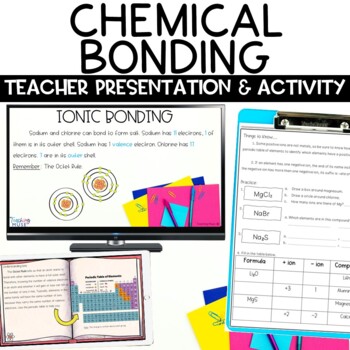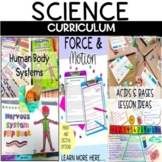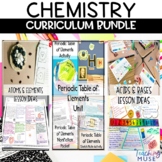Chemical Bonding Ionic and Covalent Bonding
- PDF
- Google Apps™

What educators are saying
Also included in
- Looking for a science curriculum to last all school year that will help you teach your physical science, life science, Earth science, and chemistry units? Check out everything this science curriculum has to offer. This year-long science curriculum includes science texts, hands-on activities, classroPrice $326.71Original Price $363.01Save $36.30
- Teach your students about chemistry using these materials that will allow students to read to learn about chemistry concepts and practice what they learned. This Chemistry Bundle includes states of matter, physical and chemical changes, atoms, elements, and the periodic table. This chemistry bundlePrice $100.60Original Price $125.75Save $25.15
Description
Teach students about chemical bonding such as finding ions, creating electron dot diagrams, determining chemical formulas, and covalent and ionic bonding using the included teacher presentation, printable worksheets, and digital Google Slides activities. This chemical bonding activity includes science text for students to learn about chemical bonding, worksheets to practice making ionic and covalent bonds, comprehension questions to assess knowledge, and graphic organizers to summarize information about chemical bonds.
Students will learn about:
- ions and finding the electric charge on the periodic table of elements
- how to write chemical formulas
- create electron dot diagrams
- what an ionic bond is
- what a covalent bond is
This covalent and ionic bonding activity includes:
- Sneak Peek at My Classroom: Tips and instructions on using this lesson in my classroom.
- Teacher presentation: Use the presentation to introduce the concepts to your students to evoke a classroom discussion about chemical bonding.
- Fill in Notes: Students will fill in the notes during the teacher presentation.
Printable and Google Slides versions of the following activities:
- Science text: Text covers: ions, chemical formulas, chemical bonding, covalent bonds, ionic bonds. The science text includes comprehension questions and activities to solidify understanding
- Practice bonding worksheets
- Graphic organizers
- Student copy of a periodic table that includes ion charges
- Answer key
How to use the chemical bonding materials in your classroom:
- First, introduce students to important concepts related to chemical bonding through the teacher presentation. Next, students can fill in their note sheets to document learning as you talk through the presentation. Then, students use the notes as a study sheet.
- Printable worksheets walk students through ionic and covalent bonding. They can be used to preview or reinforce concepts.
- Need sub plans? Use the student digital activity as sub plans, homework assignments, reviews, or enrichment activities.
- Have students complete the activity at a chemical bonds science station.
Other activities to support a unit on the periodic table of elements:
- Elements of Me Project
- Scavenger Hunt
- Winter Word Search
- Valentine's Day Activity
- Science Text and Worksheets
- Teacher Presentation and Digital Activity
- Periodic Table Choice Assignments
- Poster Project
Kindly Note: If you have questions, do not hesitate in emailing me at Teaching Muse's Email
PLEASE PREVIEW BEFORE PURCHASING
____________________________________________________________________________________
Thank you for visiting Teaching Muse. I would love for you to become a follower.
Teaching Muse followers receive new product information and discounts on any new items!
____________________________________________________________________________________
All rights reserved by Teaching Muse. This product is to be used by the original downloader ONLY. Copying for more than one teacher, classroom, department, school, or school system is prohibited. Additionally, this product may not be distributed or displayed digitally for public view. Failure to comply is a copyright infringement and violates the Digital Millennium Copyright Act (DMCA). They are intended for classroom and personal use ONLY.







